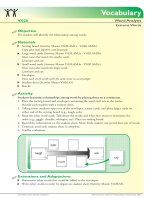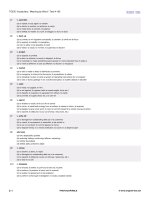VocabulaVocabulary V.020 - Word Analysis
Bạn đang xem bản rút gọn của tài liệu. Xem và tải ngay bản đầy đủ của tài liệu tại đây (1.09 MB, 52 trang )
Vocabulary
2-3 Student Center Activities: Vocabulary 2006 The Florida Center for Reading Research (Revised July, 2007)
Objective
e student will identify the relationship among words.
Materials
Sorting board (Activity Master V.020.AM1a - V.020.AM1b)
Copy, glue ends together, and laminate.
Large word cards (Activity Master V.020.AM2a - V.020.AM2b)
Have icons that match the smaller cards.
Laminate and cut.
Small word cards (Activity Master V.020.AM3a - V.020.AM3c)
Have icons that match the larger cards.
Laminate and cut.
Envelopes
Place each set of words with the same icons in an envelope.
Student sheet (Activity Master V.020.SS)
Pencils
Activity
Students determine relationships among words by placing them on a continuum.
1. Place the sorting board and envelopes containing the word card sets at the center.
Provide each student with a student sheet.
2. Taking turns, students open one of the envelopes, scatter cards, and place larger cards on
either end of the sorting board (e.g., laugh, sob).
3. Read the other word cards. Talk about the words and what they mean to determine the
order (e.g., giggle, chuckle, whimper, cry). Place on sorting board.
4. Record the information on the student sheet. Note: Each student can record four sets of words.
5. Continue until each student sheet is complete.
6. Teacher evaluation
Extensions and Adaptations
Brainstorm other words that could be added to the envelopes.
Write other words in order by degree on student sheet (Activity Master V.020.SS).
Word Analysis
Extreme Words
V.020
Vocabulary
2-3 Student Center Activities: Vocabulary2006 The Florida Center for Reading Research (Revised July, 2007)
V.020.AM1a
Extreme Words
1
2
3
VocabularyVocabulary
2-3 Student Center Activities: Vocabulary 2006 The Florida Center for Reading Research (Revised July, 2007)
Extreme Words
V.020.AM1b
4
6
5
Vocabulary
2-3 Student Center Activities: Vocabulary2006 The Florida Center for Reading Research (Revised July, 2007)
sunny sunless
excellent poor
tiny immense
screamsilent
V.020.AM2a
Extreme Words
VocabularyVocabulary
2-3 Student Center Activities: Vocabulary 2006 The Florida Center for Reading Research (Revised July, 2007)
V.020.AM2b
Extreme Words
nothing all
sunrise midnight
laugh sob
strangerrelative
Vocabulary
2-3 Student Center Activities: Vocabulary2006 The Florida Center for Reading Research (Revised July, 2007)
fair
V.020.AM3a
Extreme Words
friend
neighbor
visitor
hazy overcast
foggy
cloudy great
good average
classmate
VocabularyVocabulary
2-3 Student Center Activities: Vocabulary 2006 The Florida Center for Reading Research (Revised July, 2007)
V.020.AM3b
Extreme Words
few some
many
morning noon
afternoon
sunset
chuckle
giggle
whimper cry
several
Vocabulary
2-3 Student Center Activities: Vocabulary2006 The Florida Center for Reading Research (Revised July, 2007)
medium
big
huge
whisper
mumble
talk
V.020.AM3c
Extreme Words
small
shout
Name
2006 The Florida Center for Reading Research (Revised July, 2007) 2-3 Student Center Activities: Vocabulary
V.020.SS
Extreme Words
1
2
3
4
6
5
1
2
3
4
6
5
1
2
3
4
6
5
Vocabulary
2-3 Student Center Activities: Vocabulary2006 The Florida Center for Reading Research (Revised July, 2007)
Word Analysis
Word Wake-Up
V.021
Extensions and Adaptations
Produce more precise alternatives for other overused words (Activity Master V.021.AM3
and Activity Master V.021.SS2).
Write sentences using some of the alternative words.
Objective
e student will identify more precise alternatives for overused words.
Materials
Pocket chart
Word Wake-Up header cards (Activity Master V.021.AM1)
Word cards (Activity Master V.021.AM2a - V.021.AM2b)
Student sheet (Activity Master V.021.SS1).
Pencils
Activity
Students identify more precise words for overused words by playing a sorting game.
1. Place header cards in a row on the pocket chart. Place word cards face down
in a stack at the center. Provide each student with a student sheet.
2. Taking turns, students select the top card from the stack and read the word (e.g., joyful).
3. Look at the overused words on the headers.
4. Match the word card to the corresponding overused word (i.e., happy).
5. Place word under corresponding header and read all words in column.
6. Continue until all words are sorted.
7. Record information on a student sheet.
8. Teacher evaluation
VocabularyVocabulary
2-3 Student Center Activities: Vocabulary 2006 The Florida Center for Reading Research (Revised July, 2007)
header cards
V.021.AM1
Word Wake-Up
runbig
say happy
Vocabulary
2-3 Student Center Activities: Vocabulary2006 The Florida Center for Reading Research (Revised July, 2007)
Word Wake-Up
state shout
speak explain
huge large
immensegiant
V.021.AM2a
VocabularyVocabulary
2-3 Student Center Activities: Vocabulary 2006 The Florida Center for Reading Research (Revised July, 2007)
Word Wake-Up
cheerful content
pleased joyful
jog sprint
racedash
V.021.AM2b
2006 The Florida Center for Reading Research (Revised July, 2007)
Name
2-3 Student Center Activities: Vocabulary
Word Wake-Up
V.021.SS1
runbig
happysay
VocabularyVocabulary
2-3 Student Center Activities: Vocabulary 2006 The Florida Center for Reading Research (Revised July, 2007)
header cards
V.021.AM3
Word Wake-Up
header
header
header
header
2006 The Florida Center for Reading Research (Revised July, 2007)
Name
2-3 Student Center Activities: Vocabulary
Word Wake-Up
V.021.SS2
Vocabulary
2-3 Student Center Activities: Vocabulary 2006 The Florida Center for Reading Research (Revised July, 2007)
Extensions and Adaptations
Record sorted words and other related words on the student sheet
(Activity Master V.022.SS).
Make other headings and category cubes (Activity Master V.022.AM3).
Objective
e student will produce words for categories.
Materials
Pocket chart
Header cards (Activity Master V.022.AM1)
Category Cube (Activity Master V.022.AM2)
30 Index cards
Markers or pencils
Activity
Students produce and categorize words by rolling a cube and writing corresponding words.
1. Place Category Cube and pocket chart with header cards at the center. Place index cards
in a stack.
2. Taking turns, students roll the word cube and read the category that lands
on top (e.g., things with wheels). Say a word that goes with that category (e.g., car).
3. Write the word on an index card and read it.
4. Place the word card on the pocket chart under the correct category.
5. Continue until all the categories have five cards.
6. Peer evaluation
Word Analysis
Category Cube
V.022
pizza shirt
football
dog desk
cookie cat
car
Vocabulary
2-3 Student Center Activities: Vocabulary2006 The Florida Center for Reading Research (Revised July, 2007)
Category Cube
V.022.AM1
food
clothing
sports animals
classroom
things
things
with
wheels
VocabularyVocabulary
2-3 Student Center Activities: Vocabulary 2006 The Florida Center for Reading Research (Revised July, 2007)
Category Cube
V.022.AM2
glueglue
clothing
food
sports
things
with
wheels
classroom
things
animals
2006 The Florida Center for Reading Research (Revised July, 2007)
Name
2-3 Student Center Activities: Vocabulary
Category Cube
V.022.SS
foodclothing
classroom
things
things
with wheels
animals sports
VocabularyVocabulary
2-3 Student Center Activities: Vocabulary 2006 The Florida Center for Reading Research (Revised July, 2007)
V.022.AM3
Category Cube
glueglue
Vocabulary
2-3 Student Center Activities: Vocabulary2006 The Florida Center for Reading Research (Revised July, 2007)
Objective
e student will produce categories and corresponding words.
Materials
Large index cards
ese will be used for header cards.
Laminate.
Small index cards
ese will be used as the word cards.
Laminate.
Vis-à-Vis® markers
Student sheet (Activity Master V.023.SS)
Pencils
Activity
Students brainstorm category headings and produce words for each category.
1. Place large and small index cards at the center. Provide each student with a student sheet
and a Vis-à-Vis® marker.
2. Working in pairs, students brainstorm four headings for categories (e.g., wild animals,
types of vegetables, states, planets, things to laugh about, jobs, loud noises). Write the
agreed upon headings on large index cards. (Each student can be responsible for writing
two of the headings).
3. Identify and write five words for each category. For example, for the category of
jobs, words may include police officer, nurse, bus driver, mechanic, and teacher. (Students
can take turns writing the words.) Place cards under the corresponding heading.
4. Write the headings and words on the student sheet.
5. Teacher evaluation
Word Analysis
Category Sort
Extensions and Adaptations
Sort target words provided by the teacher and identify headings for each of the
grouped cards.
V.023
VocabularyVocabulary
2-3 Student Center Activities: Vocabulary 2006 The Florida Center for Reading Research (Revised July, 2007)
Category Sort
V.023.SS
heading
heading
heading
heading
word
word
word
word
word
word
word
word
word
word
word
word
word
word
word
word
word
word
word
word
heading
Vocabulary
2-3 Student Center Activities: Vocabulary2006 The Florida Center for Reading Research (Revised July, 2007)
Objective
e student will identify attributes of words.
Materials
Chart paper
Write target vocabulary words or write word(s) on Meaning Map when it is copied for students.
Meaning Map (Activity Master V.024.SS1)
Resources (e.g., dictionary, encyclopedia, books, textbooks).
Pencil
Activity
Students write words related to a topic and record the words on a semantic map.
1. Place resources at the center. Provide each student with a Meaning Map.
2. Student reads the target word.
3. Reads the categories or questions in each box on the Meaning Map and writes a one word
answer or sentence for each area (i.e., What is it?, Examples, Description).
4. Teacher evaluation
Extensions and Adaptations
Use other meaning maps. Write the target topic or keyword in the center of the map.
Write categories or questions in the various circles or boxes
(Activity Master V.024.SS2 and V.024.SS3).
Word Analysis
Meaning Map
V.024
Name
2006 The Florida Center for Reading Research (Revised July, 2007) 2-3 Student Center Activities: Vocabulary
V.024.SS1
Meaning Map
What is it?
Examples
Description
Word









